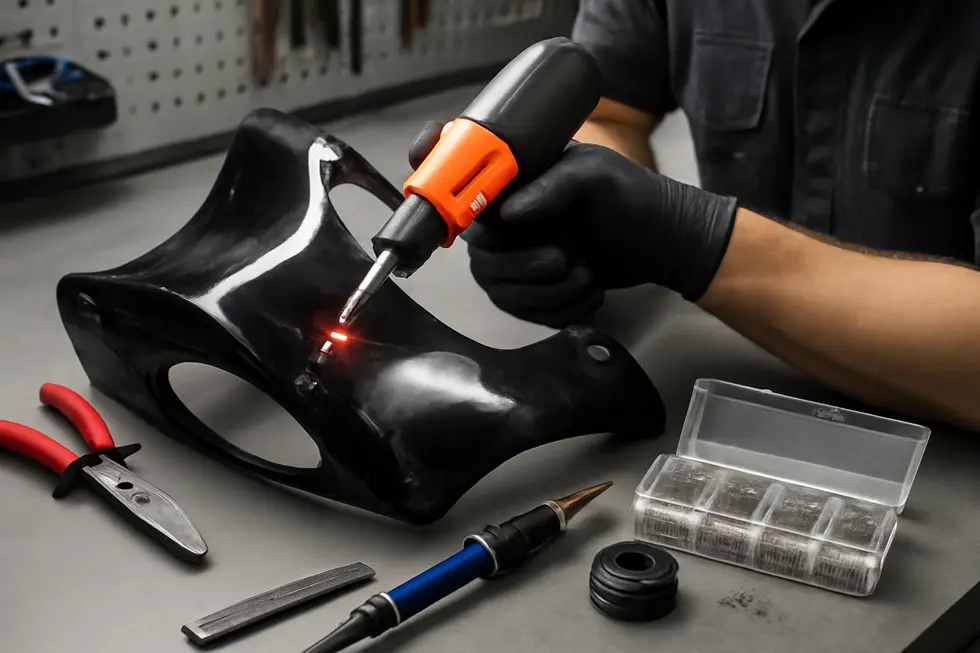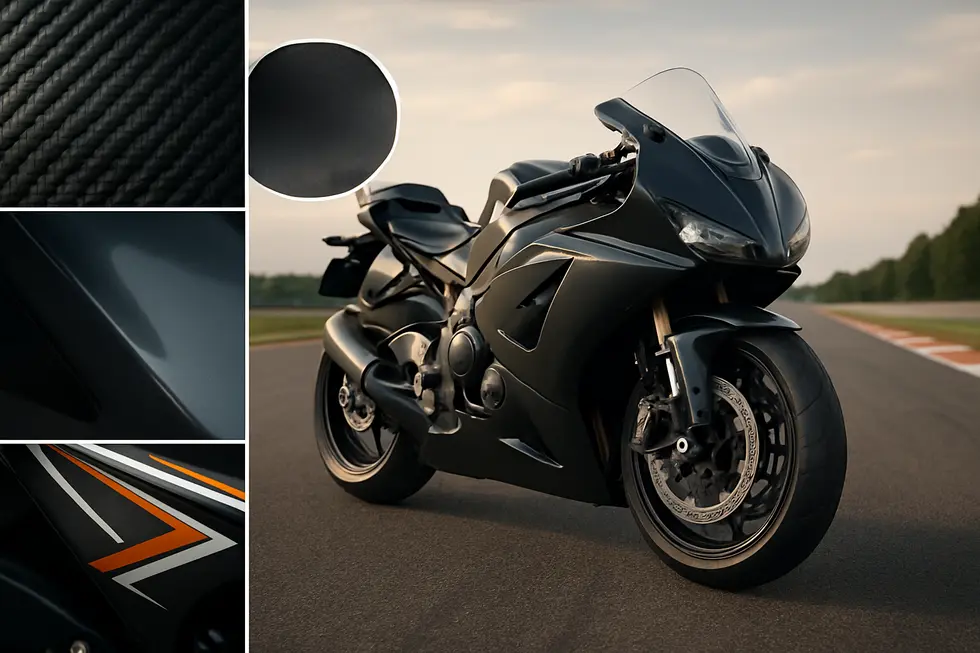Mastering Motorcycle Fairing Mold Making: A Business Owner’s Guide
September 21, 2025 | by summitfairings
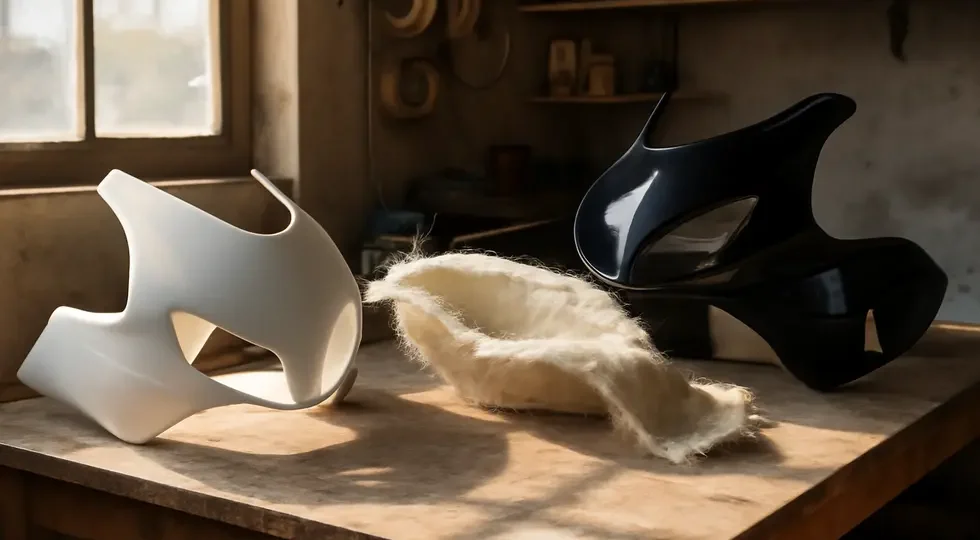
Introduction
Creating motorcycle fairing molds is a foundational process for businesses aiming to produce durable, precision-fit fairings. Success in this craft hinges on combining technical expertise with methodical process management. From initial design and plug preparation to applying gel coats, layering composites, curing, demolding, and finishing, each phase is critical. This guide unpacks these essential steps in detail to empower business owners with the knowledge needed to produce top-tier molds. Understanding these interconnected stages ensures mold integrity, repeatability, and the best outcomes for manufacturing custom or small-batch motorcycle fairings.
Tables of Contents
Chapter 1: Design and Planning in How to Make Motorcycle Fairing Molds
- Precision and Durability: Mastering Material Selection and Size Accuracy for Motorcycle Fairing Molds
- Ensuring Longevity and Precision: Maintenance and Customization in Fairing Mold Design
Chapter 2: Mastering Plug Preparation and Surface Treatment for Precise Motorcycle Fairing Molds
- Crafting a Flawless Plug: Essential Steps for Perfect Motorcycle Fairing Mold Preparation
- Mastering Surface Refinement and Ongoing Care for Durable Motorcycle Fairing Plugs and Molds
Chapter 3: Mastering Gel Coat Application for Durable Motorcycle Fairing Molds
- Precision Techniques and Material Essentials in Gel Coat Application for Motorcycle Fairing Mold Making
- Ensuring Long-Lasting Quality and Protection through Expert Gel Coat Techniques
Chapter 4: Mastering Fiberglass and Carbon Fiber Layup Techniques for Motorcycle Fairing Molds
- Essential Surface Preparation and Resin Application for Durable Motorcycle Fairing Molds
- Precision Techniques for Fiber Layup, Resin Curing, and Clean Demolding in Motorcycle Fairing Mold Fabrication
Chapter 5: Curing and Demolding Processes in How to Make Motorcycle Fairing Molds
- Mastering the Art of Curing: Essential Techniques for Durable Motorcycle Fairing Molds
- Mastering the Demolding Step: Ensuring Flawless Motorcycle Fairing Mold Release and Longevity
Chapter 6: Finishing and Use of Motorcycle Fairing Molds for Production
- Optimizing Production Quality: Advanced Finishing and Molding Technologies for Motorcycle Fairings
- Optimizing Mold Materials and Advanced Production Techniques for Superior Motorcycle Fairings
Chapter 1: Design and Planning in How to Make Motorcycle Fairing Molds
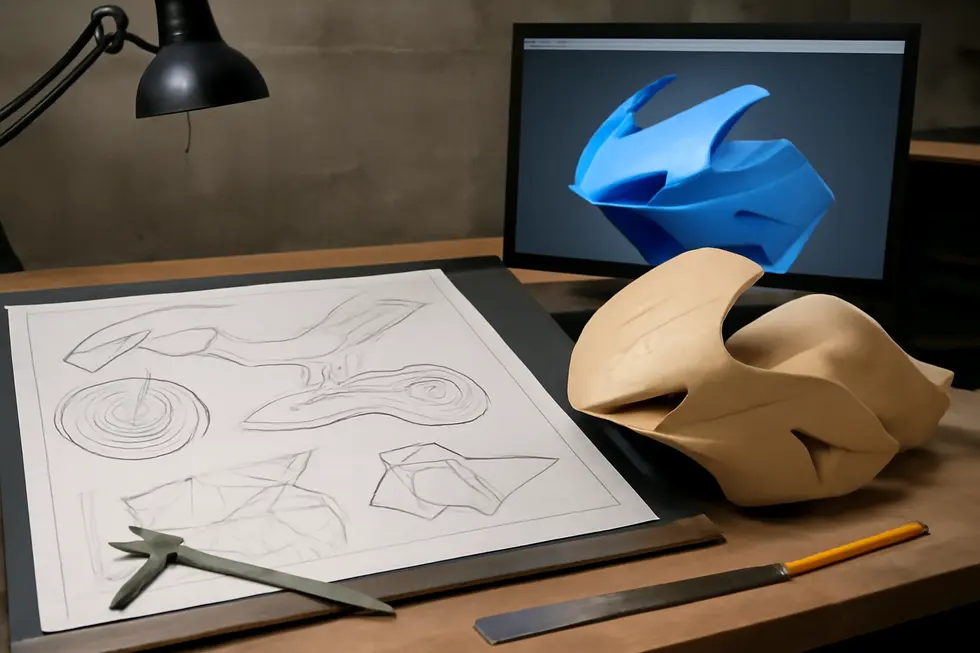
1. Precision and Durability: Mastering Material Selection and Size Accuracy for Motorcycle Fairing Molds
Crafting high-quality motorcycle fairing molds begins with meticulous attention to material selection and size accuracy, two pillars essential to ensuring durability, perfect fit, and an impeccable finish. The choice of materials directly influences the mold’s strength, weight, UV resistance, and its ability to hold paint and detail. Carbon fiber, especially dry carbon fiber with a 3K or 12K weave, is prized for its exceptional strength-to-weight ratio and long-lasting durability, making it ideal for premium molds. ABS plastic is another common choice, favored for injection molding due to its toughness and ease of shaping, particularly in smaller production runs where cost-effectiveness is key.
Achieving size accuracy begins with precise replication of the original fairing or plug. Advanced 3D scanning technology captures every contour of the original part, enabling the creation of molds that mirror the exact geometry required for an OEM-level fit. This digital precision prevents fitting issues during assembly and impacts the motorcycle’s aerodynamics positively. Subsequently, CNC machining of aluminum alloy mold blocks is often employed, offering consistent dimensional stability and surface smoothness essential to repeatable quality molding.
The integration of high-grade materials and exacting mold fabrication processes ensures the creation of molds that not only perform well but also extend the lifecycle of the mold itself. These accurate molds allow fabricators to produce fairings that fit seamlessly and maintain the bike’s design integrity. This synergy of material science and technology underpins every successful mold-making project, forming the foundation for reliable replication and exceptional end products.
For more insights on achieving precision in motorcycle fairings, explore detailed methodologies at Summit Fairings’ blog.
External reference: For a deep dive into composite materials and mold-making precision, see relevant techniques discussed in automotive molds technology here.
2. Ensuring Longevity and Precision: Maintenance and Customization in Fairing Mold Design
Effective maintenance and thoughtful customization underpin the success of motorcycle fairing mold fabrication. Regular cleaning of both the plug and molding equipment is essential to prevent dirt and resin buildup, which can degrade mold accuracy and complicate the curing process. Routine inspections of machines also sustain their efficiency, minimizing downtime and ensuring consistent replication quality. Customization begins during design planning, where selecting suitable mold sizes and materials aligned with the intended production scale enhances performance. For instance, incorporating high-grade composites or thermoplastics matched to the motorcycle’s structural and aerodynamic requirements results in molds capable of producing durable, precise fairings.
Advanced manufacturing techniques further refine this process. Calibrating CNC machines or 3D printers used for prototype molds guarantees dimensional fidelity to CAD designs, reducing the need for extensive post-processing. Combining traditional methods with hybrid composite approaches can accommodate complex shapes while maintaining mold strength and surface finish. These strategies boost adaptability, enabling tailored solutions based on production goals and material characteristics.
Moreover, employing validated prepregs and controlled curing cycles increases mold longevity by preserving fiber integrity and adhesion within composite layers. Attention to these factors ensures a balance between structural robustness and detailed surface quality, vital for high-end fairing applications. Such maintenance and design customization collectively reduce material waste, improve fitment accuracy, and sustain operational efficiency.
By integrating these measures into the design and planning phase, fabricators can consistently produce molds that meet demanding specifications with minimal defects. This approach aligns well with standards of small-batch, custom manufacturing, delivering fairings that combine precision with durability. For a deeper dive into manufacturing techniques applicable to motorcycle fairings, explore this resource on composite mold production.
Chapter 2: Mastering Plug Preparation and Surface Treatment for Precise Motorcycle Fairing Molds
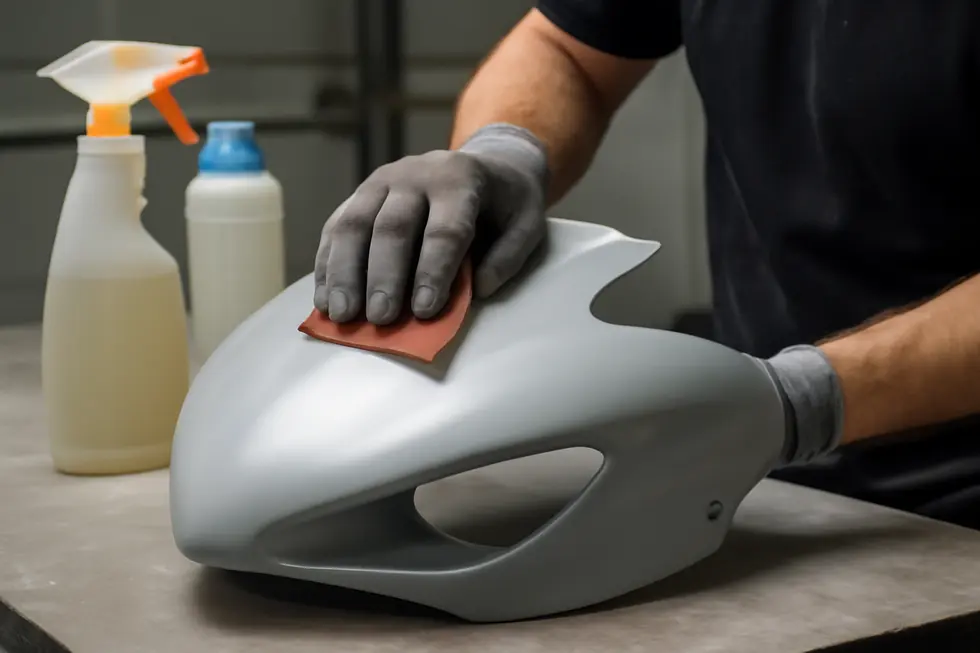
1. Crafting a Flawless Plug: Essential Steps for Perfect Motorcycle Fairing Mold Preparation
Creating an accurate and smooth plug is foundational to producing high-quality motorcycle fairing molds. This master model dictates the fit, finish, and detail of the final fairings, making meticulous preparation essential. Typically, the plug is shaped from materials such as foam, wood, or clay, chosen for their workability and stability. Complex designs often rely on CNC machining or careful carving to rough out the component’s form, which must be structurally sound to withstand mold-making stresses.
Once shaped, the plug’s surface undergoes sealing with a primer or resin layer to harden and prepare it for refinement. Imperfections like scratches, dents, or tool marks are addressed by applying layers of filler putty. Each layer is sanded progressively—from coarse to ultra-fine grits (commonly 120 up to 800)—to achieve an impeccably smooth surface. This gradual smoothing process ensures the replication of every detail by the mold without defects.
To enhance surface durability and finish, a high-gloss gel coat or automotive-grade paint is often applied. This not only provides an ultra-smooth final texture but also facilitates mold release by preventing adhesion of the mold material to the plug. Following this, multiple applications of mold release agents—such as wax or PVA film—are carefully layered to guarantee effortless separation during mold demolding.
Thorough inspection under proper lighting is indispensable throughout, catching any overlooked flaws which can then be corrected with additional filling and sanding. For increased structural integrity, reinforcing critical plug edges with fiberglass tape and epoxy is a technique borrowed from aerospace composites, ensuring shape retention during mold layup.
This attentive preparation ensures that molds capture every contour and nuance of the original design with precision, laying the groundwork for quality, durable motorcycle fairings. For further reading on the nuances of motorcycle bodywork and mold crafting, exploring expert insights can offer valuable perspectives.
Explore more about creating superior motorcycle fairings at Summit Fairings blog.
2. Mastering Surface Refinement and Ongoing Care for Durable Motorcycle Fairing Plugs and Molds
Achieving flawless motorcycle fairing molds begins with thorough surface refinement of the plug and continues with diligent maintenance of both plug and mold surfaces. Initially, the plug must undergo comprehensive sanding using progressively finer grit papers to eliminate imperfections while preserving the intended shape. For plugs made from materials like urethane foam, this step is critical to obtain a smooth foundation. Any dents or scratches encountered during this phase are often filled with high-quality fillers that harden and sand smoothly to ensure an even surface.
Following sanding, polishing transforms the plug’s surface to a glossy finish, which is essential for smooth mold release and minimizing defects once the mold is produced. Polishing compounds coupled with buffing tools enhance surface uniformity and reduce microscopic irregularities that could transfer to the mold’s gel coat layer. Once polished, the plug is cleaned meticulously to remove dust, oils, and residues that could interfere with adhesion or cause bubbles in the molding materials.
Applying surface coatings, such as a dedicated gel coat and mold release agents, protects the plug and assists in effortless mold separation after curing. For molds destined for carbon fiber fairings, multiple surface treatments improve durability and surface integrity, ensuring longevity and high-quality part reproduction.
Maintenance of the molds themselves plays an equally vital role in preserving their functionality and appearance. After each use, molds require careful cleaning to remove composite residues, preventing imperfections in future parts. Periodic polishing and reapplication of surface treatments restore mold smoothness and reduce sticking issues during layup or vacuum bagging. If damage occurs, prompt repairs keep the mold dimensionally stable and minimize scrap rates. Additionally, appropriate storage conditions—shielded from excessive humidity and temperature changes—help prevent warping or material degradation, especially in fiberglass and ABS molds.
Through this cycle of precise surface preparation and ongoing care, plugs and molds retain the smooth, defect-free qualities necessary for producing well-fitting and visually appealing motorcycle fairings. For more insights on mold care and maintenance, you can explore practical advice on maintaining quality fairings at Explore the best motorcycle fairings at Summit Fairings.
Chapter 3: Mastering Gel Coat Application for Durable Motorcycle Fairing Molds
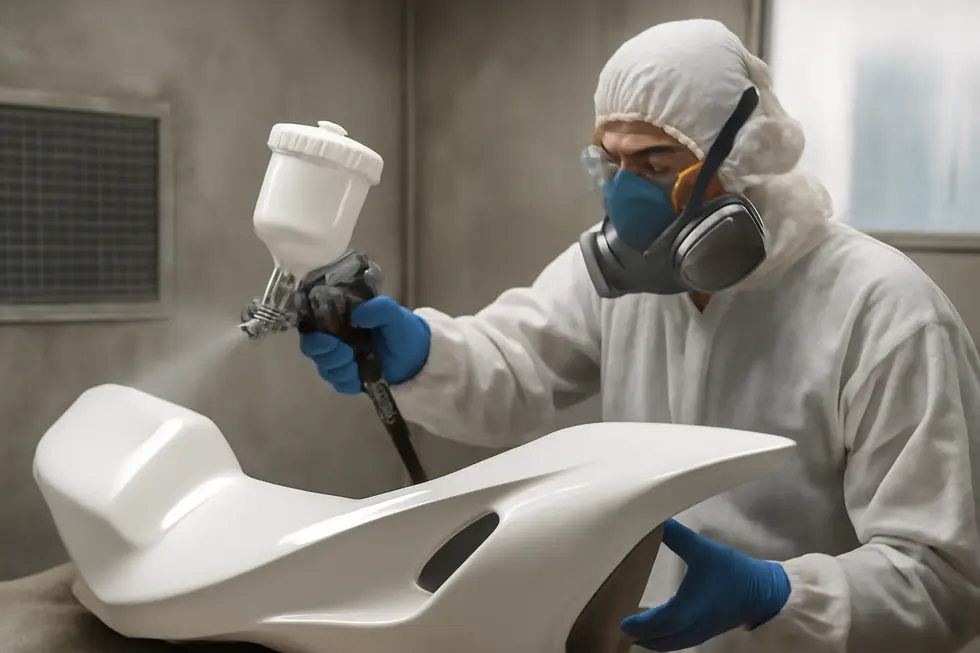
1. Precision Techniques and Material Essentials in Gel Coat Application for Motorcycle Fairing Mold Making
The application of gel coat in crafting motorcycle fairing molds is a critical step that demands precision and attention to material details to achieve a high-quality mold surface. The process begins with thorough preparation, ensuring the mold’s plug is coated with a reliable mold release agent. Typically, applying two or more coats of wax or a PVA-based release ensures the gel coat will separate cleanly after curing, preventing damage to both mold and plug.
Gel coat itself is a pigmented, catalyzed resin—usually polyester or vinyl ester—chosen for its ability to form a smooth, glossy, and hard surface. Application involves at least two layers: the initial coating establishes a solid base, while the subsequent layer builds thickness, enabling sanding and final finishing. In larger or more demanding molds, a third coat can enhance durability and finish. Gel coat thickness per layer generally ranges from 0.5 to 1 mm, balancing surface detail fidelity with structural integrity.
After gel coat application, proper curing is essential. The resin cures at room temperature or under controlled heat to achieve full hardness. Once cured, skilled sanding and polishing remove minor surface flaws and deliver the flawless finish necessary for mold precision. This surface quality directly influences the look and accuracy of all future motorcycle fairings produced from the mold.
Material specifications call for exact catalyst-to-resin ratios—commonly employing MEKP as the hardener—to ensure consistent curing and performance. Throughout the process, care with ventilation and personal protective equipment is mandatory to handle potentially hazardous fumes safely. Masking tape protects regions where gel coat is not required, maintaining clean edges.
By mastering these technical steps and adhering to material specifications, mold makers secure a durable, high-gloss surface essential for composite layups. Detailed visual guides, such as video tutorials on gel coat application, complement hands-on practice, helping refine technique for flawless mold surfaces. For a deeper dive into professional mold-making practices, refer to expert composite fabrication techniques.
2. Ensuring Long-Lasting Quality and Protection through Expert Gel Coat Techniques
Achieving a durable, high-quality gel coat finish for motorcycle fairing molds requires meticulous attention to preparation, application, and maintenance throughout the process. The foundation for a flawless gel coat begins with thorough cleaning of the mold surface to eliminate dust, grease, or any contaminants that could compromise adhesion. Equally important is the application of an effective mold release agent, commonly consisting of specialized wax layers, which prevents the gel coat from bonding permanently to the mold. This step ensures a smooth, defect-free separation and preserves both the mold and plug.
When applying the gel coat, precision in mixing the resin and hardener is crucial. Applying multiple thin, even layers rather than a single thick coat prevents curing issues such as uneven hardness or surface irregularities. Each layer must cure fully to develop optimal hardness and adhesion, forming a resilient outer shell. This shell not only provides a glossy, smooth surface but also safeguards the mold against mechanical abrasion during demolding and composite layup.
Protection from UV exposure is another pivotal factor in maintaining gel coat quality over time. UV-resistant gel coats or clear topcoats are recommended to shield the surface from yellowing and deterioration caused by sunlight, contributing to sustained aesthetic and structural integrity. Furthermore, the choice of mold material impacts gel coat performance; durable substrates like aluminum or steel offer stable dimensional accuracy and withstand repeated use without degrading the gel-coated surface.
Regular maintenance of molds—such as cleaning, inspection, and lubrication of moving parts—plays a vital role in preserving the mold’s condition. Consistent upkeep guarantees repeatable gel coat application quality and extends the lifespan of both mold and finished fairings. By integrating these practices, fabricators ensure their motorcycle fairing molds deliver reliable, long-lasting performance with excellent surface finish.
For comprehensive guidance on mold release and gel coat application techniques tailored to composite parts like motorcycle fairings, consider consulting detailed tutorials available in this resource.
Reference: Practical guides and tutorials on gel coat application and mold release for composite parts [1].
Chapter 4: Mastering Fiberglass and Carbon Fiber Layup Techniques for Motorcycle Fairing Molds
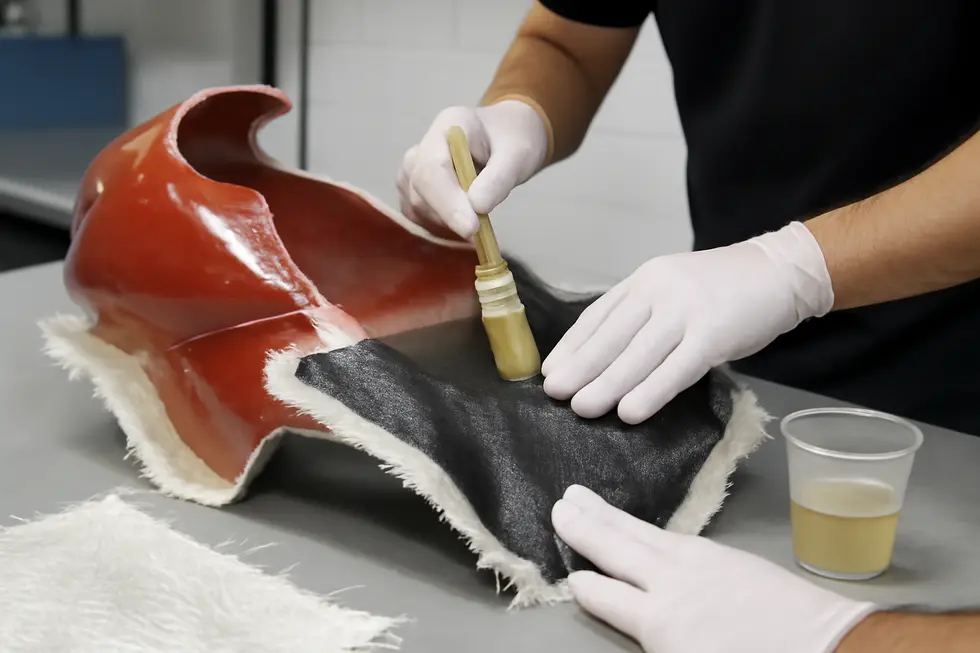
1. Essential Surface Preparation and Resin Application for Durable Motorcycle Fairing Molds
The foundation of a high-quality motorcycle fairing mold lies in meticulous surface preparation and precise resin application during the fiberglass and carbon fiber layup process. Before laying any composite materials, the mold’s surface must be rigorously cleaned to eliminate dust, oils, and contaminants that can compromise the finish and adhesion. Using manufacturer-approved cleaners and soft brushes helps protect the mold’s integrity while ensuring a pristine surface. Following cleaning, an even layer of a suitable release agent is applied to prevent permanent resin bonding, facilitating smooth demolding of cured fairings without damage.
For enhanced surface finish and durability, a gel coat or primer layer is often applied prior to fiber layup. This coat creates a hard, smooth shell ensuring the final fairings replicate the mold’s texture accurately. When applying resin—usually polyester or epoxy—full saturation of fiberglass or carbon fiber fabric is crucial. Resin must thoroughly impregnate the fibers to develop strength and structural cohesion, but care must be taken to avoid excess resin which adds unnecessary weight and can weaken the mold’s performance.
The traditional hand layup technique involves brushing or rolling resin onto the fiber layers meticulously, with vacuum bagging frequently used afterward to compact the laminate and remove air pockets, improving strength and consistency. In professional environments, carbon fiber prepreg materials impregnated with resin are favored for their superior strength-to-weight ratio, though they require precise, temperature-controlled curing.
Maintaining proper cure times and temperatures safeguards dimensional stability and mold longevity. Together, thorough cleaning, accurate application of release agents, proper resin wet-out, and controlled curing produce lightweight, durable motorcycle fairing molds that yield perfectly fitting fairings. For further insights on quality mold standards and fairing production, exploring comprehensive motorcycle fairing mold resources is highly beneficial.
2. Precision Techniques for Fiber Layup, Resin Curing, and Clean Demolding in Motorcycle Fairing Mold Fabrication
Creating durable, high-quality motorcycle fairing molds using fiberglass and carbon fiber requires mastering the intricate processes of fiber layering, resin curing, and demolding. The foundation lies in carefully applying multiple layers of pre-cut fiberglass or carbon fiber fabric onto the mold surface, typically made from metal such as aluminum or steel for rigidity and precision. Each fabric layer must be thoroughly saturated with the appropriate resin—polyester for fiberglass or epoxy for carbon fiber—to bind the fibers firmly and build the mold’s mechanical strength. Using brushes or rollers, the resin is evenly distributed to prevent wrinkles, air bubbles, and dry spots, which could compromise structural integrity or surface finish.
Once the layers are laid, curing begins. This critical phase involves the chemical hardening of resin, a process that can occur gradually at room temperature or be accelerated by controlled heat application. Heat curing promotes enhanced polymer cross-linking, producing stronger and more durable molds. Accurate monitoring of time and temperature is essential; under-curing risks a weak, brittle structure, whereas over-curing could cause distortion. Properly cured molds become rigid composites, seamlessly integrating fibers and resin into a robust form ready to withstand repeated fairing production.
Demolding follows completion of curing and requires as much care as the earlier stages. Prior application of a high-quality release agent on the mold surface prevents bonding of the composite to the mold, simplifying separation. The cured composite is gently peeled away to avoid cracking or warping delicate fairing shapes. The mold’s surface texture and release profile greatly influence demolding success; a smooth, well-prepared mold surface minimizes damage risks. Regular mold maintenance—including cleaning residual release agents and inspecting for wear—ensures consistent performance through multiple production cycles.
These interconnected steps are fundamental to fabricating motorcycle fairing molds that are both dimensionally stable and suited for manufacturing flawless bodywork. For further guidance on sourcing quality fairings and materials, see Explore the best motorcycle fairings at Summit Fairings.
[1] Process details and impact on mold quality and maintenance have been referenced from typical practices in composite layup for motorcycle fairing molds.
Chapter 5: Curing and Demolding Processes in How to Make Motorcycle Fairing Molds
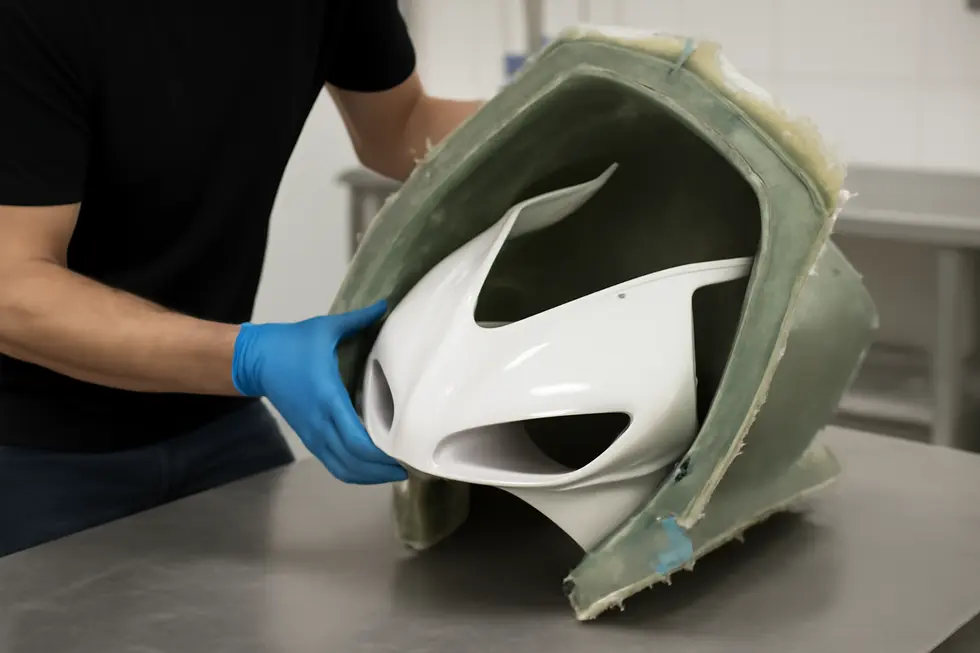
1. Mastering the Art of Curing: Essential Techniques for Durable Motorcycle Fairing Molds
The curing process is a pivotal stage in creating motorcycle fairing molds, transforming soft resin and composite layers into a rigid, durable form capable of precise replication. This process typically involves placing the prepared mold materials—such as thermoset resins or composite prepregs—into a controlled heated environment. Under carefully monitored temperature and pressure, chemical reactions within the resin initiate cross-linking, which binds the reinforcement layers into a strong, cohesive structure. Maintaining strict control over these conditions is critical, as improper curing can lead to defects like incomplete hardening, warping, or trapped air bubbles that compromise mold quality.
Timings and temperatures depend heavily on the materials used and the mold’s complexity. While thin composite molds might cure in minutes under heat and pressure, thicker or more intricate molds demand extended periods, sometimes several hours, to reach optimal strength. Once curing concludes, a crucial cooldown phase follows. Removing the mold from the heated environment only after it has sufficiently cooled ensures dimensional stability and prevents distortion or cracking during demolding.
Demolding itself requires delicate handling; the hardened mold must be separated carefully from the plug or mold cavity to preserve both the mold’s precision and the original master design. Achieving perfect results hinges on the curing process producing a uniformly rigid structure. By controlling heat, pressure, and timing, manufacturers secure molds that consistently yield accurate, durable motorcycle fairings.
This optimized curing and demolding approach underpins the quality demanded in custom fairing fabrication, blending material science and practical technique. For more insights on composite mold curing methods, see related industry resources such as Alibaba Body Armor Plate Mold.
2. Mastering the Demolding Step: Ensuring Flawless Motorcycle Fairing Mold Release and Longevity
The demolding step in motorcycle fairing mold making is a critical phase where precision and care determine the quality of the final product and the mold’s lifespan. After the composite or resin materials have fully cured, typically under controlled temperature and time conditions, the part must be removed without compromising its shape or structural integrity. Complete curing is essential: any premature removal risks warping or surface defects that impact fit and finish.
Applying an effective mold release agent before molding plays a vital role in preventing adhesion issues. These agents form a barrier that eases separation, reducing the likelihood of damaging either the delicate fairing or the mold itself. During demolding, gentle handling is imperative—often involving carefully flexing the mold or using specialized tools designed to lift the cured part without undue stress. This is especially important given the complex curves and undercuts common in motorcycle fairings, which can trap or bind parts during separation.
Maintaining mold quality goes beyond the initial release; after each demolding, thorough cleaning and inspection are required to remove residues and detect potential wear. This upkeep prolongs mold life and ensures consistent performance across multiple uses. Challenges such as incomplete curing, insufficient release agent application, or rough handling can lead to stuck parts, deformations, or damage, all of which undermine final outcomes.
By integrating controlled curing protocols, meticulous release preparation, and delicate demolding techniques, fabricators can achieve precise replication of fairings with excellent surface finish and accuracy. For additional guidance on optimal curing times and demolding methods tailored to composite materials, consulting technical datasheets and manufacturer instructions is recommended. To explore comprehensive resources on motorcycle fairing production, visit Summit Fairings blog.
Chapter 6: Finishing and Use of Motorcycle Fairing Molds for Production
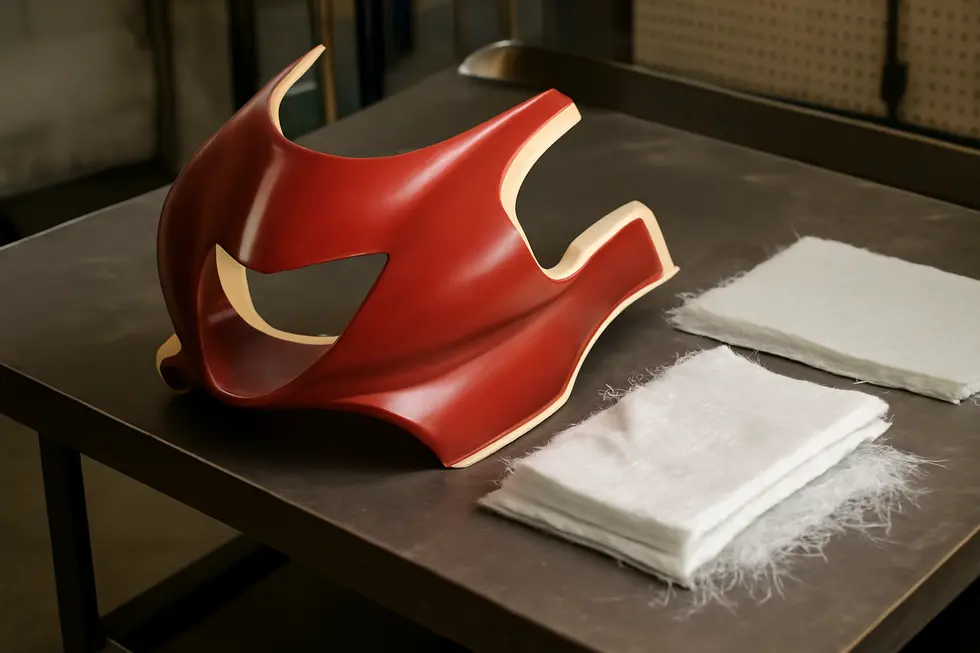
1. Optimizing Production Quality: Advanced Finishing and Molding Technologies for Motorcycle Fairings
The finishing and use of motorcycle fairing molds hinge on sophisticated technological processes that ensure high quality, durability, and repeatability in mass production. A predominant method is injection molding using thermoplastic materials, where heated plastics are precisely injected under high pressure into molds crafted with exacting detail. This process enables rapid production while maintaining exceptional dimensional accuracy and consistency across large quantities of fairings.
Critical to successful molding is the meticulous finishing of the molds themselves. After fabrication, molds undergo thorough cleaning and surface polishing to remove residues and defects, preventing imperfections in the finished parts. Routine maintenance preserves surface integrity, reduces wear, and extends mold lifespan. Specialized hardened steel or coated metal molds withstand the mechanical and thermal stresses from repeated injection cycles, ensuring stable part quality.
An increasingly popular enhancement in motorcycle fairing production is in-mold decoration technology, where graphics and decals are embedded directly into the plastic during molding. This integration results in sharper imagery with vibrant colors and superior durability, since the graphics are encapsulated within the part, eliminating issues related to peeling or fading. Such techniques also streamline post-production—lowering labor costs and reducing potential errors associated with applying stickers or paint.
The entire process—from mold preparation through injection, decoration, and finishing—relies on precision engineering and controlled cycles of heating and cooling to maintain part integrity and dimensional stability. These advanced technological methods together support efficient large-scale production of visually stunning, robust motorcycle fairings that meet stringent quality standards. For those interested in exploring more about motorcycle fairing choices and customization, resources such as Discover Affordable Motorcycle Fairings at Summit Fairings offer detailed insights.
[1] Industry standard practices for injection molding motorcycle fairings and mold maintenance protocols.
2. Optimizing Mold Materials and Advanced Production Techniques for Superior Motorcycle Fairings
Selecting the right materials for motorcycle fairing molds is essential to achieve durability, precision, and efficiency in production cycles. Aluminum and steel remain the primary choices due to their exceptional strength and heat resistance, which directly influence the mold’s lifespan and the quality of replicated fairings. Aluminum molds deliver excellent heat distribution and precision, making them ideal for detailed parts with strict dimensional tolerances. Steel molds excel in high-volume, intensive production environments thanks to their superior wear resistance, though they come with higher costs and weight considerations. Composite molds offer a lightweight alternative, particularly useful when handling or transportation demands are critical, yet they generally trade off durability and heat tolerance compared to metals.
The production techniques employed depend largely on the mold material and intended application. Compression molding is favored for producing smooth, consistent surfaces by applying heat and pressure directly within the mold cavity, ideal for thermoplastics and composite laminates. Injection molding offers high repeatability and precision through injecting molten materials under pressure, suited for thermoplastic fairings needing intricate detail. For high-performance motorcycles, autoclave curing of carbon fiber composites elevates fairing strength while minimizing weight, involving pressurized heating inside specialized ovens to bond carbon fiber layers meticulously molded to the plug.
Mold design must carefully match the fairing’s size, contour, and mounting features to ensure a perfect fit on the motorcycle. Consistent mold maintenance—including thorough cleaning, surface inspections, and lubrication of moving parts—ensures dimensional integrity and extends mold life. Neglecting upkeep can introduce defects and degrade the finish of produced fairings. Moreover, the selected mold material profoundly impacts heat management during curing cycles, affecting both production speed and final surface quality.
Integrating high-grade metal molds with precise methods such as compression molding or autoclave curing creates durable, dimensionally accurate molds that reliably produce motorcycle fairings with exceptional finish. For additional insights on variability in shapes and finishing considerations, consult resources on explore the best motorcycle fairings and detailed manufacturing techniques documented in the industry literature (Compression and Injection Molding Principles for Automobile Parts).
Final thoughts
Producing high-quality motorcycle fairing molds demands attention at every stage—from the earliest design phases through to finishing and production use. Each step builds upon the last: thoughtful design drives precise plug creation, which influences gel coat application quality and layup consistency. Proper curing and demolding preserve mold integrity, while meticulous finishing ensures molds are ready for repeated, reliable use. For business owners, mastering this process is critical to delivering fairings that meet customer expectations for fit, durability, and finish. With refined craftsmanship and process control, manufacturers can position themselves competitively in the motorcycle fairing industry, offering premium products created from superior molds.
Ready to elevate your ride? Summit Fairings delivers premium, custom-fit fairings that blend style and durability. Whether you’re chasing speed or turning heads, we’ve got your bike covered. Don’t wait—transform your machine today. Click, customize, and ride with confidence. Your perfect fairing is just a few clicks away. Act now!
About us
undefined
RELATED POSTS
View all


